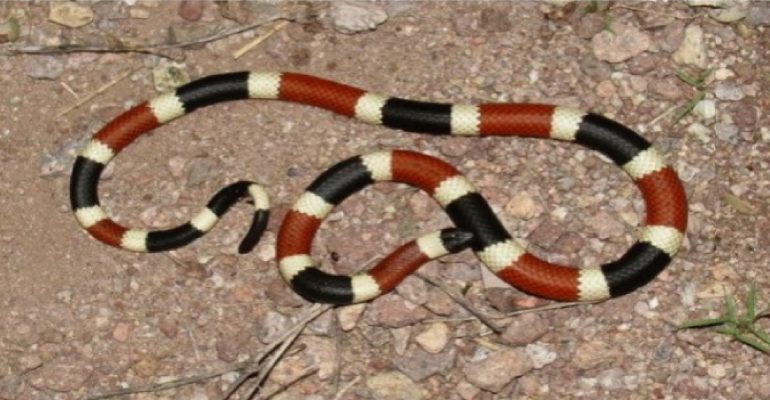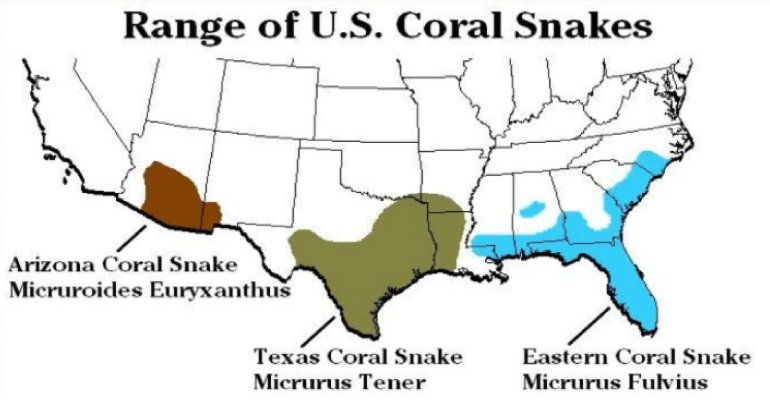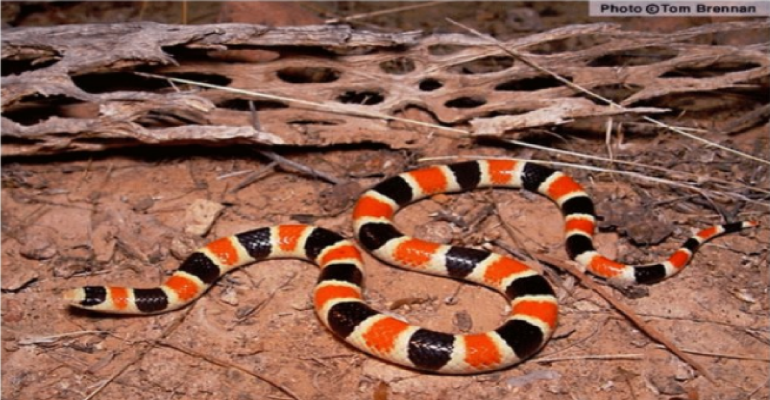
The Arizona Coral snake (Micruroides euryxanthus), also called the Sonoran Coral snake, is one of three Coral snakes in the U.S. The others are the Texas Coral snake and the Eastern Coral snake. The U.S. Coral snakes are small. Adults generally range from one to two feet long. Arizona Coral snakes occur in central and southeastern Arizona, southwestern New Mexico, and in Mexico as far south as Sinoloa. By the way, Coral snakes fart as a defensive behavior.
The Arizona Coral snake is a tri-colored snake with bright red and black bands and a third band that may be yellow, cream-colored, or white. The bands go completely around the snake. The head is black above and below from the snout to just behind the eyes. The Texas Coral snake is very similar in appearance to the Arizona variety while the Eastern Coral snake is generally darker in all its colors.
According to the Arizona-Sonora Desert Museum: “This snake occupies arid and semiarid regions in many different habitat types including thornscrub, desert-scrub, woodland, grassland and farmland. It is found in the plains and lower mountain slopes from sea level to 5800 feet (1768 m); often found in rocky areas.”

“Carnivorous, as are all snakes, the Arizona Coral snake specializes in feeding primarily on blind and black-headed snakes. Occasionally it eats lizards or other small, smooth-scaled snakes. A secretive snake, it usually emerges after sundown, and may remain active well into the night. It is also frequently active during the day after rains or if the sky is overcast. If disturbed it will bury its head in its coils, elevate and wave its tightly coiled tail, and evert its anal lining, making a popping sound. Two to three eggs are laid during the summer.”
The Arizona Coral snake has neurotoxic venom like the cobra and mamba. Its appearance is similar to two harmless kingsnakes, the Milk snake and the Mountain kingsnake. How do you tell them apart? There is a saying which has several variations but goes something like this referring the arrangement of red, black and yellow bands: “Red touch yellow, kill a fellow; red touch black, OK Jack.” That is true for all Coral snakes in the U.S., but not for Coral snakes south of Mexico. Also, there is one harmless “red touch yellow” snake in Arizona, the Sonoran shovel-nosed snake (it has a white snout).

While doing research for this article, I came upon a great website: Snakebuddies.net run by three herpetologists in Utah. They have an article: “Your Identification Guide to Tri-color snakes” which contains photos of all the Coral snakes in the U.S. and the similar-looking kingsnakes. The text explains the major points of each snake. Take a look. Some excerpts:
Myths about bites and venom:
“Unfortunately, there are at least a couple of very common myths about Coral snake bites that we want to address. You may have heard that Coral snakes have very small mouths, and can only bite you on the webbing between your fingers. This is absolutely not true. If you pick up one of these snakes, it will potentially bite any part of your body within reach. Another common myth that needs to go away, is that Coral snakes are ‘rear-fanged’ with tiny teeth, requiring them to ‘chew’ on you to inject any venom. Not only are Coral snake fangs located in the front of their mouths, as is the case with all Elapids, but they do not have to chew on you to inject venom. Although their fangs are small, they are long enough to break the skin, which allows their venom to enter your blood stream.” Unlike rattlesnakes, Coral snakes cannot fold their fangs back into their mouth.
Identification:
“Though there are some exceptions, Coral snakes are best identified by pattern. They have a solid black face, followed by a broad yellow stripe. The red, yellow, and black bands go all the way around the body, as opposed to King and Milk snakes, which have banding that stops when it reaches the belly scales. As the saying goes, Corals also have red bands surrounded on both sides by yellow bands. As burrowers, Coral snakes have very small eyes that are solid black and hard to discern from a distance greater than a few feet.”
No antivenom:
“One very notable fact to consider when dealing with any U.S. Coral snake, is that production of Coral Snake antivenom (Coralmyn) was stopped and the remaining stock of this antivenom expired in 2010. Ongoing tests have since lead to several extensions on the expiration date, but medical facilities in Florida have recently announced that they have very few vials of the serum left. Because there are so few Coral snake bites, the serum was deemed too expensive to produce, which adds to the risk of new bite victims. There is an effective antivenom available from South America, but so far the FDA refuses to allow it to be imported. In July of 2015, it was reported that the U.S. is looking into a new Coral snake antivenom.”
See more photos: http://www.reptilesofaz.org/Snakes-Subpages/h-m-euryxanthus.html
A note on terminology: “Antivenom” versus “antivenin.” According to Wikipedia: “The name “antivenin” comes from the French word venin, meaning venom, which in turn was derived from Latin venenum, meaning poison. Historically, the term antivenin was predominant around the world; its first published use being in 1895. In 1981, the World Health Organization decided that the preferred terminology in the English language would be venom and antivenom…” The quotes above used both terms interchangeably. I changed them to antivenom for consistency.
Related:
Note to readers: I have constructed a linked index to more than 300 of my ADI articles. You can see it at: https://wryheat.wordpress.com/adi-index/
Have a look and see if there is some natural history subject of interest I haven’t yet written about.
